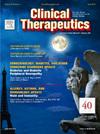Socioeconomic Disparities in Intravitreal Injection Use and Anti-VEGF Agent Selection: Aflibercept/Ranibizumab Versus Bevacizumab
IF 3.6
4区 医学
Q2 PHARMACOLOGY & PHARMACY
引用次数: 0
Abstract
Purpose
There is a paucity of research on socioeconomic factors associated with intravitreal injection use or type of anti–vascular endothelial growth factor (anti-VEGF) use. The purpose of this cross-sectional analysis is to examine the association between demographic and socioeconomic factors and intravitreal injections and type of anti-VEGF (bevacizumab, aflibercept, and ranibizumab) use for patients with diabetic macular edema, proliferative diabetic retinopathy, retinal vein occlusion, and wet age-related macular degeneration in the AllofUs Database, which is a nationwide health database initiative conducted by the National Institutes of Health in the United States to enroll participants from groups that are considered to be historically underrepresented in biomedical research.
Methods
The study population included patients diagnosed with diabetic macular edema, proliferative diabetic retinopathy, retinal vein occlusion, or wet age-related macular degeneration based on the International Classification of Diseases Ninth/10th Revision, Clinical Modification diagnosis codes. Exposures included age, sex, race/ethnicity, income, and education. Outcomes included IVI use based on the Current Procedural Terminology 4 codes and anti-VEGF type based on RxNorm codes.
Findings
Of 3010 participants, 25.9% ever had IVI use. In multivariate logistic regression analyses, those with older age (adjusted odds ratio [aOR] = 1.27; 95% CI, 1.18–1.37) and income >$150,000 (aOR = 1.71; CI, 1.27–2.32) were more likely to have had IVI use. Those with older age (aOR = 1.46; CI, 1.22–1.75), Asian/other race/ethnicity (aOR = 3.81; CI, 1.09–13.34), Hispanic race/ethnicity (aOR = 3.16; CI, 1.59–6.26), income >$150,000 (aOR = 3.20; CI, 1.45–7.06), and college graduate/advanced degree (aOR = 1.83; CI, 1.01–3.31) were more likely to have aflibercept/ranibizumab only versus bevacizumab use.
Implications
Interventions are needed to increase health literacy and access to IVI for at-risk, low-income populations. Future research should investigate patient and provider decision-making for anti-VEGF drug choice, which may have implications for cost-saving measures and policies.
玻璃体内注射使用和抗vegf药物选择的社会经济差异:阿非利塞普/雷尼单抗与贝伐单抗。
目的:缺乏与玻璃体内注射使用或抗血管内皮生长因子(anti-VEGF)使用类型相关的社会经济因素的研究。本横断面分析的目的是检查人口统计学和社会经济因素与玻璃体内注射和抗vegf类型(贝伐单抗、阿非利塞普和雷尼单抗)在AllofUs数据库中用于糖尿病黄斑水肿、增生性糖尿病视网膜病变、视网膜静脉闭塞和湿性年龄相关性黄斑变性患者之间的关系。这是一个全国性的健康数据库倡议,由美国国立卫生研究院发起,招募来自历史上被认为在生物医学研究中代表性不足的群体的参与者。方法:研究人群包括根据国际疾病分类第九/第十版临床修改诊断代码诊断为糖尿病性黄斑水肿、增殖性糖尿病视网膜病变、视网膜静脉阻塞或湿性年龄相关性黄斑变性的患者。暴露因素包括年龄、性别、种族/民族、收入和教育程度。结果包括基于现行程序术语4编码的IVI使用和基于RxNorm编码的抗vegf类型。结果:在3010名参与者中,25.9%曾经使用过静脉注射。在多因素logistic回归分析中,年龄较大的患者(校正优势比[aOR] = 1.27;95% CI, 1.18-1.37)和收入bb0 $150,000 (aOR = 1.71;CI, 1.27-2.32)更有可能使用静脉注射。年龄较大者(aOR = 1.46;CI, 1.22-1.75),亚洲/其他种族/民族(aOR = 3.81;CI, 1.09-13.34),西班牙裔种族/民族(aOR = 3.16;CI, 1.59-6.26),收入bb0 $150,000 (aOR = 3.20;CI, 1.45-7.06),大学毕业/高级学位(aOR = 1.83;CI, 1.01-3.31)与使用贝伐单抗相比,使用阿非利塞普/雷尼单抗的可能性更大。影响:需要采取干预措施,以提高高危低收入人群的健康素养和获得静脉注射免疫的机会。未来的研究应该调查患者和提供者对抗vegf药物选择的决策,这可能对节省成本的措施和政策有影响。
本文章由计算机程序翻译,如有差异,请以英文原文为准。
求助全文
约1分钟内获得全文
求助全文
来源期刊

Clinical therapeutics
医学-药学
CiteScore
6.00
自引率
3.10%
发文量
154
审稿时长
9 weeks
期刊介绍:
Clinical Therapeutics provides peer-reviewed, rapid publication of recent developments in drug and other therapies as well as in diagnostics, pharmacoeconomics, health policy, treatment outcomes, and innovations in drug and biologics research. In addition Clinical Therapeutics features updates on specific topics collated by expert Topic Editors. Clinical Therapeutics is read by a large international audience of scientists and clinicians in a variety of research, academic, and clinical practice settings. Articles are indexed by all major biomedical abstracting databases.
 求助内容:
求助内容: 应助结果提醒方式:
应助结果提醒方式:


